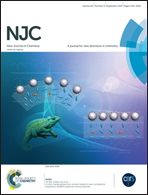Study of the performance of imidazolium-derived cations as structure directing agents in the synthesis of zeolites in fluoride media†
Abstract
Three imidazolium cations based on the imidazolium ring, 1,2,3-triethylimidazolium (123TEI), 1,2,3-triethyl-4-methylimidazolium (123TE4MI), and 2-ethyl-1,3-dimethylimidazolium (2E13DMI), were employed as structure directing agents (SDA) in the synthesis of pure silica zeolites, and led the crystallization of the STF zeolite. The three cations showed a different specificity for this phase, following the order 123TE4MI > 123TEI > 2E13DMI. Nevertheless, the 123TEI cation was also able to produce zeolite MFI when considerably high H2O/SiO2 ratios were employed. In order to understand the selectivity of these imidazolium-based SDAs and explain the experimental results, a computational study was performed, showing a perfect agreement with the experimental observations. In the case of the MFI framework, the order of interaction energies found for this framework was 123TEI > 123TE4MI > 2E13DMI, providing an explanation to the experimental results. Hence, the 123TEI cation presents a certain template effect in terms of a spatial relationship between the shape of the organic cation and the topology of the MFI structure. A higher degree of motion of the 123TEI cation is observed when occluded within the cavities of the STF framework compared to when hosted in the channel intersections of the MFI framework, explaining the different widths of the 13C NMR bands in the two materials.


 Please wait while we load your content...
Please wait while we load your content...